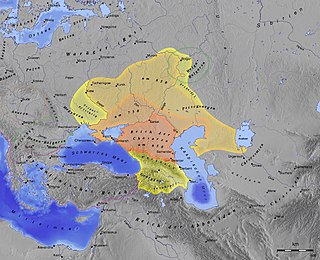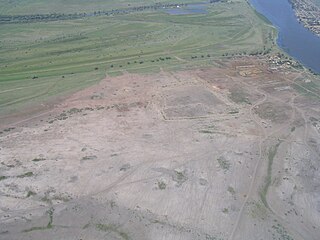
The Khazars were a nomadic Turkic people that, in the late 6th-century CE, established a major commercial empire covering the southeastern section of modern European Russia, southern Ukraine, Crimea, and Kazakhstan. They created what for its duration was the most powerful polity to emerge from the break-up of the Western Turkic Khaganate. Astride a major artery of commerce between Eastern Europe and Southwestern Asia, Khazaria became one of the foremost trading empires of the early medieval world, commanding the western marches of the Silk Road and playing a key commercial role as a crossroad between China, the Middle East and Kievan Rus'. For some three centuries the Khazars dominated the vast area extending from the Volga-Don steppes to the eastern Crimea and the northern Caucasus.
Saqsin was a medieval city that flourished from the eleventh to the thirteenth centuries. It was situated in the Volga Delta, or in the Lower Volga region, and was known in pre-Mongol times as Saksin-Bolgar, which in Mongol times became Sarai Batu. It was mentioned by the Arab geographer al-Gharnati and the Persian Qazwini, among others, and recorded as "the land of the Saksins" in the report of Friar Benedict of Poland about the 1246 trip of Giovanni da Pian del Carpine through the camp of Mongol prince Batu Khan on the shores of the Volga. S.A. Pletneva locates Saksin between present Volgograd and Akhtubinsk.
Arsiyah was the name used for a group of Muslim mercenaries in the service of the Khazar Khaganate. Whether the Arsiyah were a single tribe or composed of Muslims from a number of different tribes is unclear. Also unclear is their origin; many historians regard them as deriving from Khwarazm, but some scholars point to the fact that "As" is the Turkic term for Alans and believe that the Arsiyah were Alanic in origin. Other scholars derive the name from Iranian Auruša (white).
Joseph ben Aaron was king of the Khazars during the 950s and 960s. Joseph was the son of Aaron II, a Khazar ruler who defeated a Byzantine-inspired war against Khazaria on numerous fronts. Joseph's wife was the daughter of the king of the Alans.
Khagan Bek is the title used by the bek (generalissimo) of the Khazars.
Obadiah was the name of a Khazar ruler of the late eighth or early ninth century. He is described as coming from among "the sons of the sons" of Bulan, but whether this should be taken literally to mean that he was Bulan's grandson, or figuratively to imply a more remote descent, is unclear. King Joseph's Reply claimed that Obadiah strengthened Rabbinic Judaism and Hebrew proficiency in Khazaria by building synagogues and schools and inviting Jewish sages to the country. In Sefer ha-Ittim, Judah ben Barzillai's list of Khazar Jewish kings lacked Obadiah's name, and several scholars have concluded from this that Obadiah was a fictional character. He was succeeded by his son Hezekiah.
A Khazar ruler, mentioned in the Schechter Text and the Khazar Correspondence, Benjamin was the son of the Khazar ruler Menahem and probably reigned in the late ninth and early tenth centuries CE.
A Khazar ruler during the early 10th century CE, Aaron ben Benjamin was the son of the Khazar king Benjamin. Whether Aaron, like the rest of the Bulanids, was a Khagan or a Bek is an unresolved issue.
Baliqchi was a supposed military title used by the Khazar Khaganate. The main piece of support for the term's existence is the historiography of Theophanes the Confessor, which mention a governor of Phanagoria during Justinian II's 705 CE excursion into Khazaria by the name of Balgitzin – which has sometimes been as a Greek corruption of the title baliqchi, but this is unclear. If Balgitzin can be associated with baliqchi, then it may mean "[an executer of a labour/issue] pertaining to a walled town/stronghold", as balık in Old Turkic means "walled town, stronghold", therefore affording a title or a common name for a townwall guardian. Other meanings for baliqchi have been proposed, such as "fisherman", which might imply a connection to a naval force.
The Battle of Marj Ardabil or the Battle of Ardabil was fought on the plains surrounding the city of Ardabil in northwestern Iran in AD 730. A Khazar army led by Barjik, the son of the Khazar khagan, invaded the Umayyad provinces of Jibal and Iranian Azerbaijan in retaliation for Caliphate attacks on Khazaria during the course of the decades-long Khazar-Arab War of the early 8th century.
Menahem ben Aaron was a Khazar ruler of the late 9th century. He was the son of Aaron I and the father of Benjamin.
Hezekiah ben Obadiah was a hypothetical ruler of the Khazars, probably in the mid ninth century CE. He was the son of Obadiah, the descendant of Bulan who brought rabbinical scholars to and built yeshivot in Khazaria. Nothing is known about Hezekiah's reign and the historical authenticity and accuracy of the only document mentioning his name has been questioned. As with other Bulanid rulers, it is unclear whether Hezekiah was Khagan or Khagan Bek of the Khazars, although the latter is more likely.
Isaac ben Hanukkah was a hypothetical Jewish ruler of the Khazars mentioned in the Khazar Correspondence. He probably reigned in the mid to late ninth century CE. Little is known about his reign. As with other Bulanid rulers, it is unclear whether Isaac was Khagan or Khagan Bek of the Khazars, although the latter is more likely. He was succeeded by his son Zebulun. Historical authenticity and accuracy of the only document mentioning his name has been questioned.
Zebulun or Zevulun ben Isaac was a hypothetical Jewish Turkic ruler of the Khazars mentioned in the Khazar Correspondence. He probably reigned in the late ninth century CE. Little is known about Zebulun's reign. As with other Bulanid rulers, it is unclear whether he was Khagan or Khagan Bek of the Khazars, although the latter is more likely. Historical authenticity and accuracy of the only document mentioning his name has been questioned.
Menasseh ben Zebulun was a hypothetical Jewish ruler of the Khazars mentioned in some extant editions of the Khazar Correspondence. In some versions he is called Moshe or Moses, but this may be a result of the degradation of the text. He probably reigned in the late ninth century CE. Little is known about his reign. As with other Bulanid rulers, it is unclear whether Menasseh was Khagan or Khagan Bek of the Khazars, although the latter is more likely. Historical authenticity and accuracy of the only document mentioning his name has been questioned.
Aaron ben Nisi was a Jewish ruler of the Khazars mentioned in the Khazar Correspondence. He reigned around the year 900 AD. He was the son of Nisi ben Menasseh. Little is known about his life or reign. As with other Bulanid rulers, it is unclear whether Aaron was Khagan or Khagan Bek of the Khazars, although the latter is more likely.

The Caspian expeditions of the Rus' were military raids undertaken by the Rus' between the late 9th century and c. 1041 on the Caspian Sea shores, of what are nowadays Iran, Dagestan, and Azerbaijan. Initially, the Rus' appeared in Serkland in the 9th century travelling as merchants along the Volga trade route, selling furs, honey, and slaves. The first small-scale Viking raids took place in the late 9th and early 10th century. The Rus' undertook the first large-scale expedition in 913; having arrived on 500 ships, they pillaged in the Gorgan region, in the territory of present-day Iran, and more to the west, in Gilan and Mazandaran, taking slaves and goods. On their return, the northern raiders were attacked and defeated by the Khazars in the Volga Delta, and those who escaped were killed by the local tribes in the middle Volga.
Pax Khazarica is a historiographical term, modeled after the original phrase Pax Romana, applied to the period during which the Khazar Khaganate dominated the Pontic steppe and the Caucasus Mountains. During this period, Khazar dominion over vital trans-Eurasian trade routes facilitated travel and trade between Europe and Asia by such groups as the Radhanites and the early Rus. The originator of the term is unknown but it was in use by scholars as early as the nineteenth century.
Ishad was an Old Turkic word used to designate the highest-ranking Göktürk generals. It is also used in some Arabic sources to describe the Khagan Bek of the Khazars. Brook, citing Golden, proposes that Ishad is a variant of Shad, a Turkic title of Iranian origin.

Samosdelka is a fishing village in southern Russia near which archaeologists reported in September 2008 that they had found the remains of Atil, the capital of the medieval Khazar kingdom.









